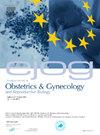Does pregnancy affect decisions regarding management of suspected adnexal torsion?
IF 2.1
4区 医学
Q2 OBSTETRICS & GYNECOLOGY
European journal of obstetrics, gynecology, and reproductive biology
Pub Date : 2025-01-31
DOI:10.1016/j.ejogrb.2025.01.052
引用次数: 0
Abstract
Objective
Decision regarding surgery in cases of suspected adnexal torsion are usually more complex when the patient is pregnant, balancing the risks of surgery to the mother and the fetus with risks of permanent ovarian damage. The aim of this study was to examine whether pregnancy affects decisions regarding management of suspected adnexal torsion cases.
Methods
This was a retrospective study conducted at a single medical center. A total of 174 women underwent a laparoscopic surgery due to suspected adnexal torsion during the study’s period. All ultrasound examinations were performed by certified ultrasound technicians or physicians. The pregnant women group was compared to non pregnant group.
Results
A total of 37 women were pregnant and 137 were not pregnant. We found that pregnant women presented more commonly with a maximal pain level (VAS 10), vomiting and peritoneal signs compared to non-pregnant women. Women in the pregnancy group were operated on significantly faster than women in the non-pregnant group (5.1 h, IQR 3–7.7, vs 9.6 h, IQR 4.6–20.6, respectively, p = 0.001). However, using a Cox regression model accounting also for extreme pain (VAS = 10), vomiting and peritoneal signs, pregnancy was not found to be a significant independent factor that reduced time to surgery. Furthermore, we showed an ovarian torsion incidence of 81.1 % among pregnant women that underwent surgery compared to only a 39.7 % in the non-pregnant group (p < 0.001).
Conclusions
Pregnant women with suspected adnexal torsion that are referred for surgery are more likely to be found with adnexal torsion and to be operated on earlier than non-pregnant women.
求助全文
约1分钟内获得全文
求助全文
来源期刊
CiteScore
4.60
自引率
3.80%
发文量
898
审稿时长
8.3 weeks
期刊介绍:
The European Journal of Obstetrics & Gynecology and Reproductive Biology is the leading general clinical journal covering the continent. It publishes peer reviewed original research articles, as well as a wide range of news, book reviews, biographical, historical and educational articles and a lively correspondence section. Fields covered include obstetrics, prenatal diagnosis, maternal-fetal medicine, perinatology, general gynecology, gynecologic oncology, uro-gynecology, reproductive medicine, infertility, reproductive endocrinology, sexual medicine and reproductive ethics. The European Journal of Obstetrics & Gynecology and Reproductive Biology provides a forum for scientific and clinical professional communication in obstetrics and gynecology throughout Europe and the world.

 求助内容:
求助内容: 应助结果提醒方式:
应助结果提醒方式:


